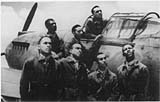| By February 1943, it seemed that the 99th would enter combat. The ground crew and pilots were given intensive training in combat tactics and were told to grasp the concepts as fast as possible. But they still sat around when white cadets were being sent over to Europe only after five weeks of training. Finally on April 2, the 99th gave farewell and boarded the evacuation train, the beginning of their long trip to Morocco, North Africa. Their trip ended in a small town called Fez. On May 1, 1943, they then moved to a new station in Fardjouna where they entered into their last phase of fighting. The pilots were attached to the 33rd Fight Group. They were finally "being integrated into the great fighting machine that was taking the battle to the enemy" (Francis 33). |

Pilots of the 99th Squadron.
From Double V: the Civil Rights Struggle of the Tuskegee Airmen |
